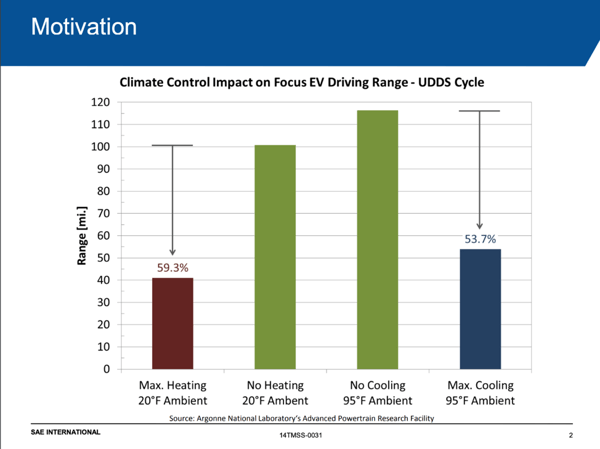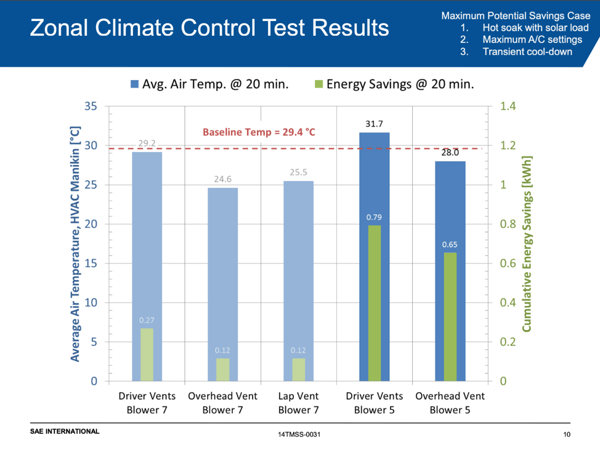For prospective electric vehicle (EV) buyers, comfort is more than just the temperature of the cabin—it's peace of mind. Many would-be customers are "cooled" from actually purchasing an EV due to range anxiety—the concern that the battery will run out of power before they reach their destination. Range anxiety and cost are cited as the two most significant barriers to purchasing.
For most people in the U.S., current EV ranges meet their needs by a long shot. The Department of Energy determined the average trip remains under 6 miles with 95% of all trips being 30 miles or less (1). Despite the numbers, people still have concerns about range, especially those who live in harsh climates.
How Weather Affects Range
Extreme weather can have a significant impact on the driving range of electric vehicles (think about those long Midwest winters or scorching Southwest summers). According to AAA, cold winter weather can reduce range by as much as 40%. On the flip side, with an outside temperature of 95 degrees, using the A/C can decrease range by 17% (2). Not only must the battery contest with the cold (or heat) of the environment, but also with the amount of energy taken by the HVAC system.
With a conventional powertrain, the energy needed for HVAC was rarely a concern. Waste heat could be used to supply warmth to the passenger cabin so that heating energy was essentially “free,” and the compressor needed for air conditioning often had a relatively small impact on fuel economy. But with an EV, every time you heat or cool the cabin, you reduce range. With range anxiety already high for potential buyers, additional energy reductions are worrisome. To grow their market, OEMs are seeking solutions for dramatic energy reductions for scenarios with extreme weather and high HVAC use.

Fig. 1. Jeffers, Matthew. “Climate Control Load Reduction Strategies for Electric Drive Vehicles" SAE 2014 Thermal Management Systems Symposium. Denver, CO. 22 September 2014.
Heat and Cool People, Not Spaces
To lessen the amount the HVAC system draws on the battery, many OEMs have started implementing localized heating and cooling systems. These systems can take the form of radiant panels, heated steering wheels, heated/ventilated seats, or zonal/local air vents. Localized heating and cooling systems are often used in conjunction with the vehicle’s HVAC system to bring comfort to the driver and passengers faster, but with less energy. Below is an example study showing the potential energy savings from a few localized systems.

Fig. 2. Jeffers, Matthew. “Climate Control Load Reduction Strategies for Electric Drive Vehicles" SAE 2014 Thermal Management Systems Symposium. Denver, CO. 22 September 2014.
Simulating a scenario that includes HVAC, localized sources, and a human model can be intricate, but it is worth it. Creating a full vehicle model will let you see how all systems work together and the perceived comfort of your customer. Extending your model set up at the beginning of your process will give you clarity and speed later on. Simulation will become an indispensable prerequisite for success in your designs.
To understand if your localized sources are going to bring greater comfort and energy savings, you will also need to model:
- HVAC
- Natural environment
- Human comfort
Size and Simulate your HVAC System
Simulating the HVAC system in conjunction with the localized systems enables you to know how to size it for improved efficiency. Due to the importance of understanding the effects on EV range, we have to be more precise in predicting the performance of the HVAC system. TAITherm allows you to define both simple and more complex 1-D fluid node networks to represent fluid flow and heat exchange within the HVAC system. These models can be enhanced by user routines (script in Python or JavaScript) which can implement complex control strategies or other dynamic inputs. Heating people, instead of spaces, brings greater efficiency and faster time-to-comfort for passengers. The balance is delicate, but through simulation you can discover an optimal solution early in your process.
Understand Human Comfort
Simulating the HVAC system and localized heating components together can give you the temperature of the cabin. However, understanding human comfort is more complicated than a simple temperature reading. Simulation can help you understand how localized heating and cooling, along with preconditioning and the interaction of human physiology, play a significant role in comfort. Without simulating comfort, you won't have an accurate indicator of customer acceptance.
Proper simulation of human comfort should include an advanced model such as the Berkeley Comfort Model, which simulates the detailed thermal complexities around the human body and predicts both sensation (how the customer feels warm or cold) and comfort (if the customer perceives discomfort or comfort) for both parts of their body or their body as a whole. Our Human Thermal Extension utilizes the Berkeley Comfort Model calculations to derive the best forecasts of human comfort. Many other comfort and physiology metrics are also included to augment the Berkeley model or capture specific phenomena.
Contextualize your Design in its Natural Environment
Cars operate in all kinds of environments. Without taking into consideration the context the vehicle is operating in, you won't have an accurate indicator of range or the range anxiety that potential customers could feel.
Simulating natural environments allows you to answer questions like "If I have a -15 C environment outside, what are the energy needs to bring that cabin to a comfortable temperature?" Simulation allows you to look at worst-case scenarios (think: coldest winter days or hottest summer days) to ensure the energy draw is manageable. You can also add more data points to get information for a typical driving experience and better predictions of the average range.
While other CAE software can help model natural weather environments, TAITherm provides a more flexible and user-friendly experience. Utilizing the same physics (air temperature, wind speed, and solar loads), TAITherm provides detailed weather information in a library or allows you to plug in your own latitude and longitude values for solar load predictions. TAITherm also enables you to run transient effects, such as a moving sun, which is especially helpful for more extended, real-world simulations.
Couple Thermal Results with Energy Predictions
Easily send your thermal results to vehicle dynamics or other system tool to consider energy prediction. TAITherm uses standard exports (.csv or other) so you can send temperature/heat rate profiles and steady or transient results to your energy prediction software.
Depending on how complex of a scenario you want to analyze, you can utilize steady-state or transient conditions to determine your thermal circumstances and energy draw. From a steady-state perspective, you could simulate a vehicle operating with unchanging conditions (cruising speed with A/C or heat at a constant rate) to determine how long the battery would last. To perform a more real-world simulation, you would conduct a longer-term, transient analysis. A possible scenario would be to model how much energy it takes to do a cabin warm-up two or three times a day together with a typical driving scenario. This type of advanced scenario would create actionable results for figuring out power consumption. A similar experiment could then be designed to simulate days, weeks, or even months of typical driving scenarios to determine the statistical range considerations and comfort metrics for the driver of the vehicle.
For more complex simulations, you might want to couple with a 1D or system tool where you can have full component representation of your complete HVAC system. TAITherm couples intuitively with GT-SUITE and Amesim for more detailed simulations where the design of the HVAC system (compressor and other components) is integral to determining the necessary electrical power from the battery. These powerful coupled simulations allow you to include both 3D heat transfer effects and their influence on complex vehicle systems.
Adopt Simulation Techniques
Adopting these advanced simulation techniques where you can observe these systems working together allows you to adjust your design before going to prototype. Simulation also enables you to consider customers physical comfort and improve peace of mind for those living in more extreme environments.
References
1. Fotw #1042, August 13, 2018: In 2017 Nearly 60% Of All Vehicle Trips Were Less Than Six Miles https://www.energy.gov/eere/vehicles/articles/fotw-1042-august-13-2018-2017-nearly-60-all-vehicle-trips-were-less-six-miles2. Cold Weather Reduces Electric Vehicle Range
https://newsroom.aaa.com/2019/02/cold-weather-reduces-electric-vehicle-range/
Fig. 1. Jeffers, M., Chaney, L., and Rugh, J., "Climate Control Load Reduction Strategies for Electric Drive Vehicles in Warm Weather," SAE Technical Paper 2015-01-0355, 2015, doi:10.4271/2015-01-0355.
Fig. 2. Jeffers, M., Chaney, L., and Rugh, J., "Climate Control Load Reduction Strategies for Electric Drive Vehicles in Warm Weather," SAE Technical Paper 2015-01-0355, 2015, doi:10.4271/2015-01-0355.
